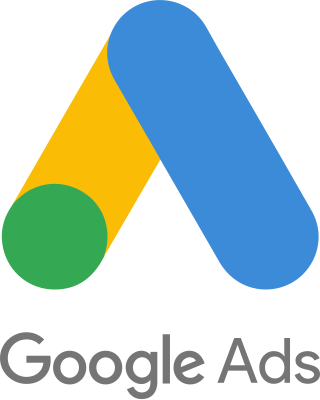Related Research Articles
Digital display advertising is online graphic advertising through banners, text, images, video, and audio. The main purpose of digital display advertising is to post company ads on third-party websites. A display ad is usually interactive, which allows brands and advertisers to engage deeper with the users. A display ad can also be a companion ad for a non-clickable video ad.

Google Ads formerly known as Google Adwords is an online advertising platform developed by Google, where advertisers bid to display brief advertisements, service offerings, product listings, and videos to web users. It can place ads in the results of search engines like Google Search, mobile apps, videos, and on non-search websites. Services are offered under a pay-per-click (PPC) pricing model, and a cost-per-view (CPV) pricing model.
Online advertising, also known as online marketing, Internet advertising, digital advertising or web advertising, is a form of marketing and advertising that uses the Internet to promote products and services to audiences and platform users. Online advertising includes email marketing, search engine marketing (SEM), social media marketing, many types of display advertising, and mobile advertising. Advertisements are increasingly being delivered via automated software systems operating across multiple websites, media services and platforms, known as programmatic advertising.
In marketing, promotion refers to any type of marketing communication used to inform target audiences of the relative merits of a product, service, brand or issue, persuasively. It helps marketers to create a distinctive place in customers' mind, it can be either a cognitive or emotional route. The aim of promotion is to increase brand awareness, create interest, generate sales or create brand loyalty. It is one of the basic elements of the market mix, which includes the four Ps, i.e., product, price, place, and promotion.

Microsoft Advertising is an online advertising platform developed by Microsoft, where advertisers bid to display brief ads, service offers, product listings and videos to web users. Provides pay per click advertising on search engines Bing, Yahoo! and DuckDuckGo, as well as on other websites, mobile apps, and videos.
Social media optimization (SMO) is the use of online platforms to generate income or publicity to increase the awareness of a brand, event, product or service. Types of social media involved include RSS feeds, blogging sites, social bookmarking sites, social news websites, video sharing websites such as Youtube and social networking sites such as Facebook, Instagram, Tiktok and X(Twitter). SMO is similar to search engine optimization (SEO) in that the goal is to drive web traffic, and draw attention to a company or creator. SMO's focal point is on gaining organic links to social media content. In contrast, SEO's core is about reaching the top of the search engine hierarchy. In general, social media optimization refers to optimizing a website and its content to encourage more users to use and share links to the website across social media and networking sites.
Keyword advertising is a form of online advertising in which an advertiser pays to have an advertisement appear in the results listing when a person uses a particular phrase to search the Web, typically by employing a search engine. The particular phrase is composed of one or more key terms that are linked to one or more advertisements. The most common form or keyword advertising, focused on payment methods, is pay per click (PPC), with other forms being cost per action (CPA) or cost per mille (CPM).
Mobile advertising is a form of advertising via mobile (wireless) phones or other mobile devices. It is a subset of mobile marketing, mobile advertising can take place as text ads via SMS, or banner advertisements that appear embedded in a mobile web site.

Digital marketing is the component of marketing that uses the Internet and online-based digital technologies such as desktop computers, mobile phones, and other digital media and platforms to promote products and services. It has significantly transformed the way brands and businesses utilize technology for marketing since the 1990s and 2000s. As digital platforms became increasingly incorporated into marketing plans and everyday life, and as people increasingly used digital devices instead of visiting physical shops, digital marketing campaigns have become prevalent, employing combinations of search engine optimization (SEO), search engine marketing (SEM), content marketing, influencer marketing, content automation, campaign marketing, data-driven marketing, e-commerce marketing, social media marketing, social media optimization, e-mail direct marketing, display advertising, e-books, and optical disks and games have become commonplace. Digital marketing extends to non-Internet channels that provide digital media, such as television, mobile phones, callbacks, and on-hold mobile ringtones. The extension to non-Internet channels differentiates digital marketing from online marketing.

Targeted advertising is a form of advertising, including online advertising, that is directed towards an audience with certain traits, based on the product or person the advertiser is promoting.
Social network advertising, also known as social media targeting, is a group of terms used to describe forms of online advertising and digital marketing that focus on social networking services. A significant aspect of this type of advertising is that advertisers can take advantage of users' demographic information, psychographics, and other data points to target their ads.

Social media marketing is the use of social media platforms and websites to promote a product or service. Although the terms e-marketing and digital marketing are still dominant in academia, social media marketing is becoming more popular for both practitioners and researchers.
Site retargeting is a display advertising technique used by marketers to display advertising to people who have previously visited their website. The marketer includes a pixel within their webpage which sets a cookie in the user's browser. That cookie allows the marketer to target the website visitor with advertising elsewhere on the internet using retargeting.
Social advertising is advertising that relies on social information or networks in generating, targeting, and delivering marketing communications. Many current examples of social advertising use a particular Internet service to collect social information, establish and maintain relationships with consumers, and for delivering communications. For example, the advertising platforms provided by Google, Twitter, and Facebook involve targeting and presenting ads based on relationships articulated on those same services. Social advertising can be part of a broader social media marketing strategy designed to connect with consumers.
Oracle Advertising, formerly Datalogix, is a cloud-based consumer data collection, activation, and measurement platform for use by digital advertisers. Datalogix was a consumer data collection company based in Westminster, Colorado that provided offline consumer spending data to marketers. In December 2014, Oracle signed an agreement to acquire Datalogix. After the acquisition, Datalogix's name changed to Oracle Data Cloud, which later became Oracle Advertising. Oracle Advertising is part of the Oracle Advertising and Customer Experience (CX) application suite.
Adobe Experience Cloud (AEC), formerly Adobe Marketing Cloud (AMC), is a collection of integrated online marketing and web analytics products by Adobe.
"Project Alamo" was a database of voter information created for Donald Trump's 2016 presidential campaign and an associated fundraising and political advertising operation on social media platforms. It was organized by the Giles-Parscale firm in San Antonio, Texas. The campaign paid Giles-Parscale as much as $94 million for fundraising, political advertising, and digital media services, including the creation of Trump's website. A new database of voter information named "Project Alamo" was at the heart of Giles-Parscale's efforts, allowing highly targeted advertising on social media platforms. The advertising campaigns added to the database over time, driving more effective targeting. The scale of the fundraising and political advertising campaigns on social media was massive, with hundreds of thousands of targeted ads being delivered daily. Project Alamo has been credited as an important factor in Trump's 2016 victory.

Advertising revenue is the monetary income that individuals and businesses earn from displaying paid advertisements on their websites, social media channels, or other platforms surrounding their internet-based content. In September 2018, the U.S Internet advertising market was estimated to be worth $111 billion, with market share being held mostly between Google, Facebook, Amazon, and Microsoft. These companies earn revenue through online advertising but also have initiated pathways for individual users and social media influencers to earn an income. Individuals and businesses can earn advertising revenue through advertising networks such as Google AdSense, YouTube monetization, or Outbrain.
SimpleReach is a content data platform and performance measurement company that provides a platform to measure social action and track social behavior on published content. Their machine learning and AI data help marketers adjust their content to better serve customers. The company was founded in 2010 by CEO Edward Kim and is based in New York. As of March 2019, the company operates as a subsidiary of Nativo, Inc.

Meta Platforms, Inc., doing business as Meta, and formerly named Facebook, Inc., and TheFacebook, Inc., is an American multinational technology conglomerate based in Menlo Park, California. The company owns and operates Facebook, Instagram, Threads, and WhatsApp, among other products and services. Advertising accounts for 97.8 percent of its revenue. Originally known as the parent company of the Facebook service, as Facebook, Inc., it was rebranded to its current name in 2021 to "reflect its focus on building the metaverse", an integrated environment linking the company's products and services.
References
- ↑ "CUSTOMER ON FACEBOOK - NCMA" (PDF). google.com.hk. Retrieved 18 March 2018.
- ↑ "How to Use Facebook Lookalike Audiences | WordStream". www.wordstream.com. Retrieved 18 March 2018.
- ↑ "About similar audiences for Search" . Retrieved August 8, 2019.
- ↑ "Look-a-like Audiences Solution For Advertisers" . Retrieved August 8, 2019.
- ↑ "Lookalike Targeting" . Retrieved August 8, 2019.
- ↑ "Targeting with LinkedIn Lookalike Audiences – Overview" . Retrieved August 8, 2019.
- ↑ "What's a Facebook lookalike audience and why is it important?". Bigcommerce. Retrieved 18 March 2018.
- ↑ "The Power of Lookalike Audiences". Online Advertising School. 5 December 2016. Retrieved 18 March 2018.
- ↑ Shpivak, Etgar (June 6, 2019). "How to Best Scale Lookalike Audiences". Kenshoo. Retrieved August 8, 2019.
- 1 2 "About Lookalike Audiences" . Retrieved September 28, 2021.
- ↑ "Lookalike Audiences: Why You Can't Ignore Them - South Agency". South Agency. 24 April 2017. Retrieved 18 March 2018.
- ↑ Levy, Elad (April 25, 2019). "7 eCommerce Lookalike Audiences That Are Worth Testing". Ladder. Retrieved August 8, 2019.
- ↑ Basis, Ehud (October 29, 2018). "Scaling Paid Campaigns via User Engagement Signals". Outbrain. Retrieved August 8, 2019.
- ↑ "Ticketfly Community". community.ticketfly.com. Retrieved 18 March 2018.
- ↑ "Advantages of WCA Facebook advertising with analysis and comparison of efficiency to classic Facebook advertising" (PDF). google scholar. Retrieved 18 March 2018.
- ↑ "DSIM- Digital Marketing Blog". Digital Marketing Blog - DSIM. Retrieved 18 March 2018.
- ↑ "Facebook Custom Audience Terms of Service: Are You Breaking the Rules? - Jon Loomer Digital". Jon Loomer Digital. 31 October 2013. Retrieved 18 March 2018.
- ↑ "Facebook removes age, gender and ZIP code targeting for housing, employment, credit ads" . Retrieved August 8, 2019.
- ↑ Feiner, Lauren (June 21, 2022). "DOJ settles lawsuit with Facebook over allegedly discriminatory housing advertising". CNBC. Retrieved July 26, 2022.
- ↑ Nix, Naomi; Dwoskin, Elizabeth (June 21, 2022). "Justice Department and Meta settle landmark housing discrimination case". The Washington Post. Retrieved July 26, 2022.
- ↑ "United States Attorney Resolves Groundbreaking Suit Against Meta Platforms, Inc., Formerly Known As Facebook, To Address Discriminatory Advertising For Housing" (Press release). U.S. Justice Department. June 21, 2022. Retrieved July 26, 2022.